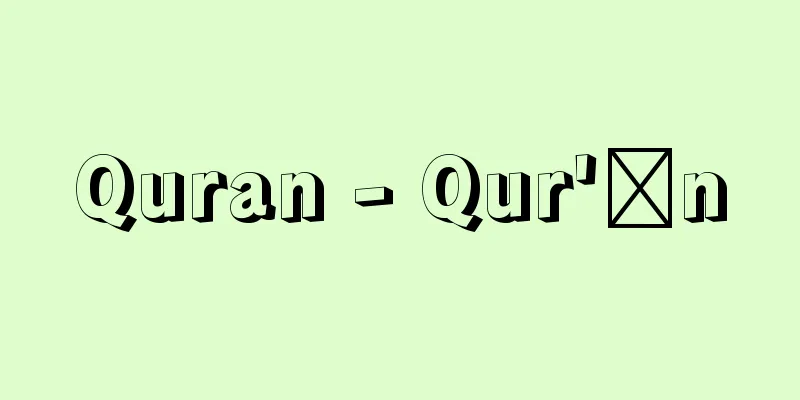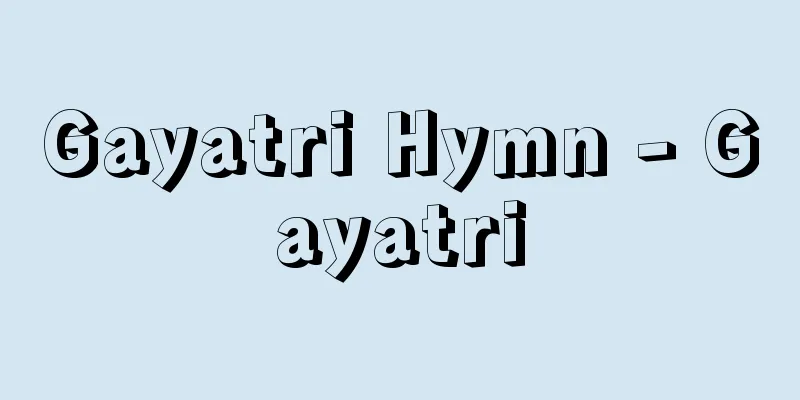Quran - Qur'ān

|
The fundamental scripture of Islam, written in Arabic. Strictly speaking, it is called the "Qur'an." qur'ān is traditionally a noun derived from the Arabic verb qara'a, and its original meaning is said to be "to recite," but there are various theories about the meaning and origin of this word. The Quran is a collection of revelations that God (Allah) read to Muhammad (Mohammed) from the "Mother of Scriptures" in heaven over a period of more than 20 years, which were then memorized and later collected by people. [Nakamura Hirojiro] Structure and styleThe Quran consists of 114 chapters. The length of each chapter varies, from as long as 286 verses (Chapter 2) to as short as just 3 verses (Chapter 103, for example). Except for the "Chapter of the Opening" (Chapter 1), the chapters are arranged in reverse chronological order, with the earlier chapters generally being shorter. Each chapter has a name, such as "The Cow," "The Woman," or "The Table," but these names do not represent the subject of the chapter, and are merely names, like people's names. The Quran does not have a consistent story in the usual sense. The first reason is that God often speaks in the first person about various issues from time to time, so the topics change in the same chapter. The second reason is that every single word of Arabic is the word of God, strictly distinguished from human language, and all literary artifice is removed and the Quran is collected as it is. This is one of the reasons why the Quran is considered difficult for outsiders to read. It also accounts for the traditional Muslim attitude of refusing translation and stubbornly clinging to the "Arabic Quran." The Quran is a rhymed prose poem in the Sajoo script. In the early Meccan period, oaths were used frequently, and the style of writing is reminiscent of the shamans of the time. The words uttered in a short, divine state are rich in images, stimulating the imagination and creating a strange atmosphere, expressing well the approaching end of the world and its fear, and the creepiness of the terrifying invisible world. This concise, taut style gradually loosens, and in the later Meccan period, the content becomes more about past events and stories. Furthermore, in the Medina period, the number of tasteless legal regulations increases, reflecting the real situation established by the Islamic community (Ummah), and the style becomes verbose. [Nakamura Hirojiro] Quran recitationThe Quran is not to be read silently, but to be recited out loud. This is one of the attractions of the Quran. The perfect recitation by a professional Quran reciter (Kari, Muqri) drives the listener into ecstasy. In Islam, which does not permit religious music or icons, the poetic, metrical and musical beauty of the recitation of the Quran in Arabic, which exceeds the human ability, has been elevated to the level of religious art. Thus, the Quran is recited not only during prayers but also on every occasion in daily life, and in traditional education, children were first made to memorize the Quran. In the Islamic world, calligraphy, which makes use of the curvaceous beauty of Arabic characters, developed early on, and verses from the Quran have been used to decorate spaces such as the walls of mosques. [Nakamura Hirojiro] Establishment of the definitive editionIt was after the death of the Prophet Muhammad that the Quran took on its current definitive form. According to legend, the Quran was compiled twice. The first time was during the time of the first caliph, Abu Bakr (573-634), when many memorizers of the Quran were killed in successive wars, and the compilation was carried out out of fear that the Quran would be lost. The second time was during the time of the third caliph, Uthman (?-656), when differences in the text of the Quran caused conflict among warriors, so a new compilation was carried out to confirm the definitive text, and the variant texts were burned. Although each of these traditions has been criticized, this is how the Uthman edition that is known to us today was created. However, at that time, the Arabic writing system was extremely incomplete, and various readings of the same text emerged. During that time, various vowel marks and other marks were invented, and from the beginning of the 10th century, the text gradually moved toward unification, and the readings of the seven schools were officially recognized. One of these was used as the standard text published by the Egyptian government in 1924, and since then this reading has been widely used in the Islamic world today. [Nakamura Hirojiro] Significance and contentThe Quran is considered to be the eternal word of God. The most fundamental principle in Islam is "submission to God" (islām), which specifically means following the words of the Quran. Thus, the Quran regulates the thoughts and actions of Muslims as the ultimate standard for judging what is right and wrong in all areas of daily life. The contents of the Quran are roughly divided into three parts. The first is the creed. It contains revelations about the concept of God, the creation of the world, the creation of Adam and Eve and their expulsion from Paradise, the history of mankind and God's guidance, human disobedience and God's punishment, the end of the world, the resurrection of the dead and judgment, heaven and hell, and so on. The second is ethics. This clarifies the concrete form of obedience to God, along with the following legal norms. For example, helping orphans, the poor, and travelers, honoring parents, encouraging good deeds, and correcting wrongdoing. It also includes etiquette and manners. The third is legal norms. This is divided into two. The first is the ritual norms that state the obligations that humans owe directly to God. For example, purification, prayer, charity, fasting, and pilgrimage. The other is the norms of legal obligations that humans owe to each other, including marriage, divorce, support, inheritance, buying and selling, and punishment. By using these limited norms as a core and supplementing and expanding them with the traditions of the Prophet (hadith) and other sources, Islamic law (Sharia) was later established to regulate the entire lives of Muslims. [Nakamura Hirojiro] Research and TranslationIn Europe, the publication of the Quranic text and its translation into Latin and other languages began in the mid-16th century. However, it was not until the 19th century that Quranic studies began in the true sense of the word. First, G. Flügel published his textual revision (1834) and concordance (1842), which marked the start of serious Quranic studies. In 1860, Th. Nöldeke published his groundbreaking study of the dating of each chapter of the Quran and the process by which the Quranic text was created, entitled "History of the Quran." After being revised by F. Schwally (1909-1919), this work remains a must-read today and serves as the basis for many subsequent Quranic studies and translations. In Japan, there are old translations of the Quran by Okawa Shumei and others, but translations from the original texts by Izutsu Toshihiko, Fujimoto Katsuji, Ban Yasuya (Bankousai), Ikeda Osamu, and the Japan Muslim Association, each with their own characteristics. Research and overview books include "Creation and the End Times" by Makino Shinya, "Structure of Meaning" by Izutsu Toshihiko, and "Reading the Quran" by the same author, all of which are about the ideas and worldview of the Quran. [Nakamura Hirojiro] "The Quran, translated by Izutsu Toshihiko, 3 volumes (Iwanami Bunko)" ▽ "The Quran, translated by Fujimoto Katsuji, Ban Yasuya, and Ikeda Osamu (1970, Chuokoron-Shinsha)" ▽ "The Holy Quran, compiled and published by the Japan Muslim Association (1982)" ▽ "Creation and the End of Days, by Makino Shinya (1972, Shinsensha)" ▽ "The Structure of Meaning, by Izutsu Toshihiko (1972, Shinsensha)" ▽ "Reading the Quran, by Izutsu Toshihiko (1983, Iwanami Shoten)" [References] | |Source: Shogakukan Encyclopedia Nipponica About Encyclopedia Nipponica Information | Legend |
|
アラビア語で書かれたイスラムの根本聖典。厳密にいえば「クルアーン」。qur'ānは伝統的にはアラビア語の動詞qara'aから派生した名詞で、本来の意味は「読誦(どくじゅ)」であるとされているが、この語の意味と起源については諸説がある。コーランは、20余年にわたって神(アッラー)が、天使ガブリエルを通してムハンマド(マホメット)に、天にある「啓典の母体」から読み聞かせたとされる啓示を人々が記憶し、のちに集録したものである。 [中村廣治郎] 構成と文体コーランは114の章からなる。各章の長さはまちまちで、長いもので286節(第2章)、短いものでわずか3節からなる(たとえば第103章など)。「開扉の章」(第1章)を除けば、ほぼ長い章から順に配列されている。概して初期の章ほど短いので、その構成は年代とは逆の順序になっている。各章には「牝牛(めうし)」「女」「食卓」などの名があるが、章の主題を表すものではなく、人名と同じく単なる名称にすぎない。そもそもコーランには通常の意味での一貫したストーリーがない。その理由として第一に、そこでは神が多くの場合一人称で雑多な問題についておりおりに語りかける形式をとっているため、同一の章のなかでも話題はさまざまに変わっていること。第二に、アラビア語の一字一句がそのまま神のことばとして、人間のことばと厳しく区別され、文学的作為はすべて排除されてそのまま集録されたことがあげられる。このことが外部の人間にとってコーランが読みにくいと思われる一因でもある。また、伝統的に翻訳を拒否し、かたくなに「アラビア語のコーラン」に固執するムスリム(イスラム教徒)の態度もそこに起因する。 コーランは、サジュウ体とよばれる脚韻を踏んだ散文詩である。メッカ時代初期では、そのうえ誓言が多用され、文体は当時のシャーマンの語り口を思わせる。一種の神憑(かみがか)り状態のなかで短く吐き出されることばはイメージに富み、想像力を刺激して異様な雰囲気を醸し出し、迫りくる終末とその恐怖、おどろおどろしい不可視の世界の不気味さをよく表現している。このような簡潔で引き締まった文体は徐々に弛緩(しかん)していき、メッカ後期になると内容的にも過去の事件や物語が多くなる。さらにメディナ期になると、イスラム共同体(ウンマ)が確立した現実状況を反映して無味な法的規範が多くなり、文体も冗長(じょうちょう)になる。 [中村廣治郎] コーランの読誦コーランは黙読するよりも、朗々と声を出して読誦するものである。そこにコーランの魅力の一つがある。専門のコーラン読み(カーリ、ムクリ)の完璧(かんぺき)な朗誦(ろうしょう)は聞く者を恍惚(こうこつ)とさせる。宗教音楽もイコンも認めないイスラムでは、このアラビア語のコーラン読誦がもつ人間業(わざ)を超えた詩的韻律美と音楽的朗誦美は宗教芸術の域にまで高められた。こうしてコーランは礼拝のときだけではなく、日常生活のあらゆる機会に読誦され、伝統的教育では児童はまずコーランの暗誦をさせられたのである。またイスラム世界では、アラビア文字の曲線美を生かした書道が早くから発達し、モスクの壁面などの空間にコーランの章句が装飾に用いられてきた。 [中村廣治郎] 定本の成立コーランが現在のような定本の形をとるようになったのは預言者ムハンマドの死後のことである。伝承によれば、コーランの結集(けつじゅう)は二度行われたという。1回目は初代カリフ、アブー・バクル(573―634)のときで、相次ぐ戦争でコーランの記憶者が多数戦死したため、コーランの消失を恐れて結集が行われたという。2回目は3代目カリフ、ウスマーン(?―656)のときで、コーラン本文の違いが戦士たちの間に対立を生んだことから、定本確定のために改めて結集が行われ、異本が焼却されたという。これらの伝承にはそれぞれ批判が加えられているが、このようにして今日に伝わるウスマーン本が成立した。しかし、当時においては、アラビア文字の表記法がきわめて不完全であったことから、同じテクストに対してさまざまな読み方が現れた。その間、母音符号その他の符号が種々考案され、10世紀初めから徐々に統一に向かい、7学派の読み方が公認された。そのなかの一つが1924年にエジプト政府が刊行したテクストの定本として用いられ、それ以降は、その読み方が今日のイスラム世界で広く用いられている。 [中村廣治郎] 意義と内容コーランは神の永遠なることばと考えられている。イスラムでもっとも基本的なことは「神への服従」(イスラームislām)であるが、それは具体的にはコーランのことばに従うことである。こうしてコーランは、日常生活の全分野にわたる人間の正邪善悪に関する判断の究極的基準として、ムスリムの思考や行動を規制する。 コーランの内容は三つに大別される。第一が信条。それには神観念、天地創造、アダムとイブの創造と楽園追放、人類の歴史と神の導き、人間の不服従と神罰、終末、死者の復活と審判、天国と地獄、などについての啓示がある。第二が倫理。これは次の法的規範とともに、神に服従するその具体的形式を明らかにしたものである。たとえば、孤児や貧者や旅人を助け、親を敬い、善行を勧め、不正を匡(ただ)すことなど。そのほか、礼儀作法やエチケットの類もこのなかに入る。第三が法的規範。これは二つに分けられ、一つは人間が直接神に負う義務を述べた儀礼的規範。たとえば、浄(きよ)め、礼拝、喜捨(きしゃ)、断食(だんじき)、巡礼。他の一つは人間が相互に負う法的義務規範で、婚姻・離婚、扶養、相続、売買、刑罰などが含まれる。これらの限られた規範を核とし、それを預言者の伝承(ハディース)などによって補足・拡大することによって、のちにムスリムの全生活を規制するイスラム法(シャリーア)が成立する。 [中村廣治郎] 研究と翻訳ヨーロッパでは、コーラン・テクストの刊行およびラテン語その他の言語への翻訳は16世紀中ごろから始まった。しかし、真の意味でのコーラン研究が始まるのは19世紀になってからである。まず、フリューゲルG. Flügelのテクスト校訂(1834)と用語索引(1842)が刊行されて本格的なコーラン研究がスタートした。1860年には、ネルデケTh. Nöldekeによるコーラン各章の年代、およびコーラン・テクストの成立過程についての画期的研究が『コーランの歴史』として刊行された。本書はその後シュワリーF. Schwallyの改訂(1909~1919)を経て今日でも必読の文献として、その後のさまざまなコーラン研究や翻訳の基礎となっている。 日本では、コーランの邦訳としては古くは大川周明などのものがあるが、原典からの翻訳としては、井筒俊彦、藤本勝次・伴康哉(ばんこうさい)・池田修、日本ムスリム協会の訳があり、それぞれ特徴をもっている。研究書・概説書には、牧野信也著『創造と終末』、井筒俊彦著『意味の構造』、同著『コーランを読む』などがあり、いずれもコーランの思想や世界観に関するものである。 [中村廣治郎] 『井筒俊彦訳『コーラン』全3冊(岩波文庫)』▽『藤本勝次・伴康哉・池田修訳『コーラン』(1970・中央公論社)』▽『日本ムスリム協会編・刊『聖クラーン』(1982)』▽『牧野信也著『創造と終末』(1972・新泉社)』▽『井筒俊彦著『意味の構造』(1972・新泉社)』▽『井筒俊彦著『コーランを読む』(1983・岩波書店)』 [参照項目] | |出典 小学館 日本大百科全書(ニッポニカ)日本大百科全書(ニッポニカ)について 情報 | 凡例 |
<<: Golan Heights - Golan Heights (English spelling)
>>: Collin (English spelling) Louis-Joseph-Raphaël Collin
Recommend
Pathan (English spelling)
...the Aryan people who live throughout Afghanist...
Kitayama [village] - Kitayama
A village in Higashimuro District, on the eastern ...
Wallace, D.
… [Development of various magazines] The success ...
Distant friendship and close attack -
In 270 BC, during the Warring States period in Ch...
Yoshikiyo Yokoyama
Year of death: December 2, 1879 Year of birth: 182...
dotted print
…Relief printing is an exception, being limited t...
Laurvicite
…Black granite has an extremely small coefficient...
Inozaki Ritsusai
…However, by the time of Enyo (?-1758), there had...
Royal residence - Oryo
〘 noun 〙 (meaning "goryo-nin") 1. Bikuni...
Meggers, BJ (English spelling) MeggersBJ
...Those who study the development of culture fro...
Means test
In Japan, the term was "asset survey," b...
Shachiburi - tadpole fish
A marine fish belonging to the family Orcinidae, ...
Obata Seto - Obata Seto
A narrow strait in the southeastern part of Yamagu...
Osumi [town] - Osumi
A former town in Soo County in eastern Kagoshima P...
Alligator - Alligator
A general term for crocodiles belonging to the Al...









